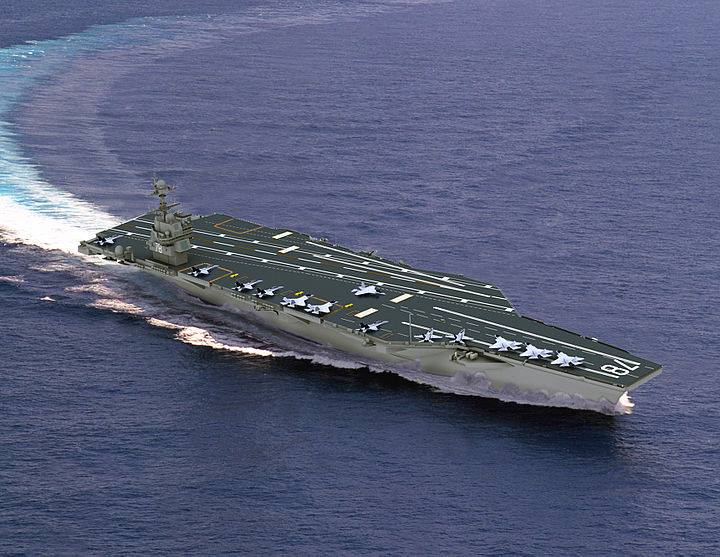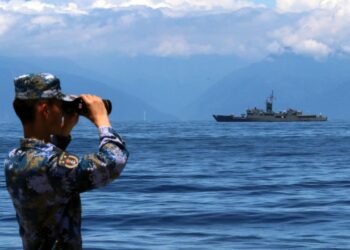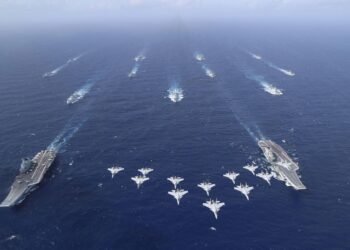Recently, the Project On Government Oversight reported on the unaffordability of the Navy’s long-term shipbuilding budget and on the fact that its acquisition plans will actually cost much more than the service expects. According to the Congressional Budget Office, which uses a more realistic way of evaluating long-term acquisition plans, the Navy will need $76 billion more than it has budgeted for over the next three decades. This is on top of a pre-existing $60 billion budget shortfall resulting from the forthcoming Ohio-class replacement submarine program.
Congress has come up with a gimmicky way to help relieve some of the Navy’s budget pressure, but the exploding costs of another Navy program, the Ford-class carrier, are sure to raise eyebrows amongst those concerned with runaway procurement programs.
The first vessel of this new class, also named the USS Gerald Ford, has experienced dramatic cost growth since the contract was initiated in 2008. And now, a new report from the Government Accountability Office, the auditing arm of the federal government, says that further cost increases are likely despite the Navy employing budget games to mask the vessel’s final cost.
The U.S. Navy currently operates ten Nimitz-class aircraft carriers, the largest warships ever built, each with a full-load displacement of over 100,000 tons. The United States also operates nine large-deck amphibious assault ships, which are like smaller versions of aircraft carriers capable of launching helicopters, Harrier jump jets, and, once they’re operational, F-35Bs.
As the first of the Nimitz-class carriers nears decommissioning next decade, the Navy is planning on procuring at least three (and up to ten) new Ford-class carriers to replace them. The service is debuting a number of new technologies and improvements on the Ford-class carriers that it claims will reduce acquisition and lifecycle costs while increasing combat power.
Due to their large size and incredibly complex nature, aircraft carries take many years to build. The USS Gerald Ford has been under construction at Newport News Shipbuilding in Virginia since 2008. In order to ensure that budget targets were met, Congress enacted a cost cap on the first vessel in Fiscal Year 2007, which was initially set at $10.5 billion. The following two carriers, the USS John F. Kennedy and USS Enterprise, were capped at $8.1 billion each.
Since then, Congress has amended the law to increase the cap on the USS Gerald Ford’s overall cost to $12.9 billion, a whopping $2.4 billion increase for one ship. Congress has also increased the cost caps on the following two carriers from $8.1 billion to $11.4 billion each.
Perhaps unsurprisingly, GAO is now warning that further cost increases are likely. “With the shipbuilder embarking on one of the most complex phases of construction with the greatest likelihood for cost growth, cost increases beyond the current $12.9 billion cost cap appear likely,” GAO noted in its report.
Fear not, though: the Navy has an accounting gimmick that it hopes will help mask this massive cost increase and absolve Congress of the embarrassing need to further increase the vessel’s cost cap. The Navy plans to defer work on the USS Gerald Ford until after the ship is delivered in order to save money in the short-term. Because post-delivery costs are not included in the end cost of the ship, the Navy is able to mask its total price tag. GAO, however, remains unconvinced: “In essence, the Navy will have a ship that is less complete than initially planned at ship delivery, but at a greater cost.”
The incoming chairman of the Senate Armed Services Committee, Senator John McCain (R-AZ), isn’t buying it either: “After $2.4 billion in cost overruns on this ship already, the Navy is trying to artificially shift more cost overruns until after the Ford’s delivery. The Armed Services Committee will be seeking further explanation from the Navy on this troubling report and will work to hold those responsible for these cost overruns accountable.”
In addition to delaying the introduction of the new vessel, this strategy threatens to compress the operational testing of the new carrier, which also carries risk. According to GAO, “This means that there will be less time for operational testing, which is the Navy’s opportunity to test and evaluate the ship against realistic conditions before its first deployment.”
This also means that the USS Gerald Ford will deploy without having demonstrated key performance metrics, like increased sortie generation rate (the rate at which the carrier can deploy aircraft), which is supposed to be one of the main improvements of the Ford-class over the previous Nimitz-class carriers. Additionally, the two technologies that are central to increased sortie generation rate, the Electromagnetic Aircraft Launch System and Advanced Arresting Gear, both suffer from low levels of reliability.
Another key improvement that the Navy touted when making the case for the Ford-class carriers was decreased manning levels, which would save costs by reducing the number of sailors necessary to operate the ship. However, due to increased sortie generation and the low levels of reliability exhibited in key technologies, GAO has found that the Navy is unlikely to realize reduced manning levels and increased capability concurrently. Perhaps most alarmingly, GAO found that the first of the new class of carriers, the USS Gerald Ford, “may not achieve improved operational performance over the Nimitz class.”
Ultimately, GAO recommends that the Navy increase accountability in the program by “requiring that all work included in the initial ship cost estimate” be counted against the statutory cost cap. This would inevitably require the Navy to seek congressional authorization to increase the cost cap in law—a step the Navy would clearly rather avoid.
Every two years, the Congressional Budget Office outlines ways to achieve significant deficit reduction. In its most recent report, CBO delineated how much funding could be saved by forgoing additional Ford-class carriers beyond the USS Gerald Ford and USS John F. Kennedy.
According to CBO, cancelling the procurement of Ford-class carriers beginning in 2018 would save the U.S. taxpayer close to $20 billion over the next decade. CBO notes,
“At some point in the future, the large aircraft carrier may no longer be an effective weapon system for defending U.S. interests overseas as new technologies designed to threaten and destroy surface ships are developed and spread to many countries. Among the technologies that might threaten the future survivability of the carrier are long-range supersonic antiship cruise missiles, antiship ballistic missiles, very quiet submarines, and satellite tracking systems and other sensors.”
Last year, Navy Captain Henry Hendrix authored a report which cast doubt on the long-term efficacy of relying so heavily on aircraft carriers as a means of projecting power. In his report entitled At What Cost a Carrier? Captain Hendrix explored the evolution of modern aircraft carriers, their vulnerabilities, and the growing technological capacity of China to target American carriers with conventional ballistic missiles.
As a result, Captain Hendrix recommended that the United States slowly divest itself of aircraft carriers.
POGO also believes the Navy should slim its carrier fleet either by cancelling future orders of Ford-class orders or by retiring some of the older Nimitz-class carriers earlier than scheduled. CBO has found that by retiring the USS George Washington earlier than scheduled and reducing the number of carriers in the fleet, the United States would save $7 billion over ten years.
The Navy clearly cannot afford all of its long-term acquisition priorities, and something will eventually give. The Pentagon should reexamine its strategic requirement to operate eleven aircraft carriers and twelve ballistic missile submarines along with the antiquated notion that the United States must field a three-hundred vessel fleet. This would save actual taxpayer dollars instead of the Navy’s current plan to employ budget gimmicks to try and cover the true costs of its carrier and strategic submarine fleet.
To use the Navy’s own terminology, its long-term shipbuilding plan is “unsustainable.” For years, POGO and others have suggested ways to make it more affordable. Perhaps the Navy should lend us an ear.











